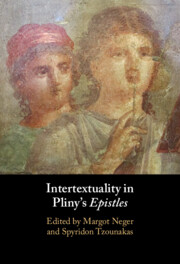Book contents
- Intertextuality in Pliny’s Epistles
- Intertextuality in Pliny’s Epistles
- Copyright page
- Contents
- Contributors
- Acknowledgements
- Abbreviations
- Introduction
- Part I Intertextuality and Interdiscursivity in Pliny’s Letters
- Chapter 1 Pliny, Man of Many Parts (Lucretius, Cicero, Valerius Maximus, Tacitus)
- Chapter 2 Intertextuality in Pliny, Epistles 6
- Chapter 3 Discourses of Authority in Pliny, Epistles 10
- Part II Models and Anti-Models: Pliny’s Interaction with Oratory and Natural History
- Part III Pliny and Seneca: Discourses of Grief and Posthumous Reputation
- Part IV Pliny’s Villas and Their Poetic Models
- Part V Pliny Turns Nasty: Satire and the Scoptic Tradition
- Part VI Final Thoughts: Discourses of Representation and Reproduction
- Bibliography
- General Subject Index
- Index Locorum
Chapter 2 - Intertextuality in Pliny, Epistles 6
from Part I - Intertextuality and Interdiscursivity in Pliny’s Letters
Published online by Cambridge University Press: 07 September 2023
- Intertextuality in Pliny’s Epistles
- Intertextuality in Pliny’s Epistles
- Copyright page
- Contents
- Contributors
- Acknowledgements
- Abbreviations
- Introduction
- Part I Intertextuality and Interdiscursivity in Pliny’s Letters
- Chapter 1 Pliny, Man of Many Parts (Lucretius, Cicero, Valerius Maximus, Tacitus)
- Chapter 2 Intertextuality in Pliny, Epistles 6
- Chapter 3 Discourses of Authority in Pliny, Epistles 10
- Part II Models and Anti-Models: Pliny’s Interaction with Oratory and Natural History
- Part III Pliny and Seneca: Discourses of Grief and Posthumous Reputation
- Part IV Pliny’s Villas and Their Poetic Models
- Part V Pliny Turns Nasty: Satire and the Scoptic Tradition
- Part VI Final Thoughts: Discourses of Representation and Reproduction
- Bibliography
- General Subject Index
- Index Locorum
Summary
How does Plinian intertextuality contribute to making a book unit distinctive from its fellows? Taking Book 6 as its subject, this chapter first looks at the depth of intertextual investment made by Pliny in the second Vesuvius letter (6.20), and looks at the challenge set by its apparent references to Petronius. It then looks at the persistent intertextual presence across Book 6 of Cicero, Catullus, Vergil, Quintilian and Tacitus, and argues for a coherent programme of engagement particularly with Vergil, Quintilian and the Dialogus of Tacitus. The chapter ends by reflecting on why Pliny appeared to have good reason in the early second-century CE to be confident about the vigour and life-expectancy of public oratory at Rome.
- Type
- Chapter
- Information
- Intertextuality in Pliny's Epistles , pp. 47 - 66Publisher: Cambridge University PressPrint publication year: 2023

